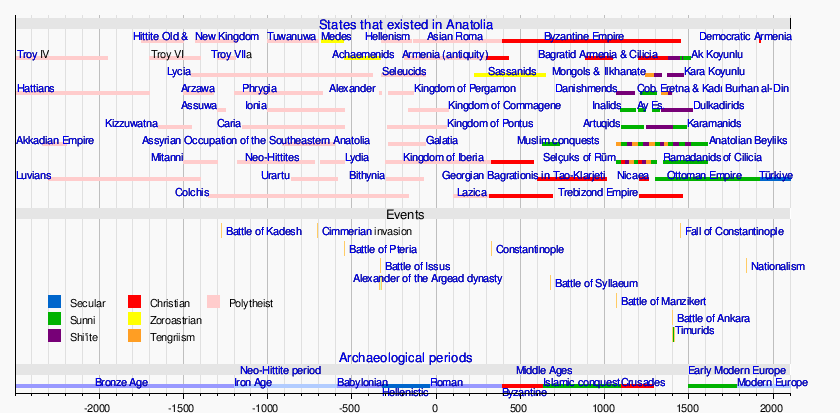Kingdom of Cilicia (ancient)
Kingdom of Cilicia was an independent state that existed from 612BC to 549BC. The state was governed by the Syennesis dynasty, possibly from Greeks that moved into Cilicia towards the end the of the Bronze Age. Prior and after the independent kingdom, Syennesis dynasty ruled Cilicia as autonomous state under the Neo-Assyrian Empire, Achaemenid Empire and the Kingdom of Alexander.
Kingdom of Cilicia Hilakku | |||||||||
|---|---|---|---|---|---|---|---|---|---|
| 612BC–549BC | |||||||||
| Status | Independent | ||||||||
| Capital | Tarsus | ||||||||
| Common languages | Hieroglyphic Luwian, West Semitic Phoenician | ||||||||
| Religion | Luwian religion | ||||||||
| Government | Kingdom | ||||||||
| Syennesis | |||||||||
• 612BC | Syennesis I | ||||||||
| Historical era | Iron Age | ||||||||
• Established | 612BC | ||||||||
• Disestablished | 549BC | ||||||||
| |||||||||
| Today part of | |||||||||
History
Cilicians could manage to protect themselves from Assyrian domination and with the dissolution of the Neo-Assyrian Empire in 612BC, they could manage to establish to build their fully independent kingdom. As being at a geography that is strategically significant, Cilicians could manage to expand their kingdom as north as Halys River in a short period. With the expansions, Cilician Kingdom became as strong as Babylonia, one of the powerhouses of the time.
In 585BC, Herodotus praised Cilician king Syennesis I, the founder of the kingdom, for his efforts in leading negotiations in ending the 5 years' war between Lydia and Median Kingdom.
War broke out between the two countries and continued for five years, during which both the Lydians and Medes won a number of victories. On one occasion they had an unexpected battle in the dark, an event which occurred after five years of indecisive warfare. The two armies had already engaged and the fight was in progress, when the day was suddenly turned into night. [...] Both Lydians and Medes broke off the engagement when they saw this darkening of the day; they were more anxious than they had been to conclude peace, and a reconciliation was brought about by Syennesis, a Cilician, and Labynetus of Babylon, who were the men responsible both for the pact to keep the peace and for the exchange of marriages between the two kingdoms. They persuaded Alyattes to give his daughter Aryenis to Astyages, son of Cyaxares - knowing that treaties seldom remain intact without powerful sanctions.[1]
Peaceful governance conducted by the Syennesis dynasty, not only kept the kingdom survive, also prevented Achemeneid Empire to attacks Lydians, after Achaemenid invasions of Median lands. Appuašu, the son of Syennessis, defended the country against the Babylonian king Neriglissar campaign, whose army reached Cilicia and crossed the Taurus mountain range. Achaemenids could manage to defeat Lydians, thus Appuašu had to recognize the authority of the Persians in 549BBC to keep the local administration with the Cilicians. Cilicia became an autonomous satrapy under the reign of Cyrus II.[2]
Cilicians were independent in their internal affairs and kept this autonomy for almost 150 years. In 401, Syennesis III and his wife Epyaxa supported the revolt of Cyrus the Younger against his brother Artaxerxes II Mnemon. This was sound policy, because otherwise, Cilicia would have been looted by the rebel army. However, after the defeat of Cyrus at Cunaxa, Syennesis' position was difficult. Most scholars assume that this behavior marked the end of the independence of Cilicia. After 400, it became a normal satrapy.[3]
Government and Military
Except the independent period between 612 to 549BC, Cilicians had mostly an autonomous governance under the protection of Neo-Assyrian Empire, Achaemenid Empire and the Empire of Alexander. As a satrapy of the Achameneid Empire, Cilicians were independent in their internal affairs. Achaemenid satrapies had to pay annual tax to the Persian Emperor. According to Heredotus, as the fourth satrapy in rank, Cilicia had to give 500 talent silver (approx. 1.3 tonnes) and 360 white horses. Due their extended autonomy, Cilicians paid more tax than the other satrapies.
Cilicians could manage the strengthen their navy equivalent to their army during the satrapy times. Cilicians had 600 ships at the time they were in charge to suppress the Greek revolts at the western Minor Asia coasts. Navy privates were mostly made up of Phoenicians, thus Cilicians and Cypriots were in high ranks in the Achaemenid Navy. Heredotus praised the naval skills of Cilicians in his articles.
Syennesis dynasty
- Syennesis I: The founder of the kingdom
- Appuašu: Son of Syennesis I
- Oromedon: The father of Syennesis II
- Syennesis II: The son of Oromedon and was probably the grandson of Appuwašu. He is mentioned as one of the commanders in the Persian navy during Xerxes' invasion of Greece (480 BCE). He married his daughter to Pixodarus, a Carian leader.
- Syennesis III: Probably the grandson of Syennesis II. He was married to Epyaxa.
References
- Heredotus & Histories, p. 1.74..
- Kasım Ener. "Adana İl Yıllığı". Adana Valiliği. Retrieved 28 March 2020.
- Jona Lendering. "Syennesis I". Livius. Retrieved 29 March 2020.
